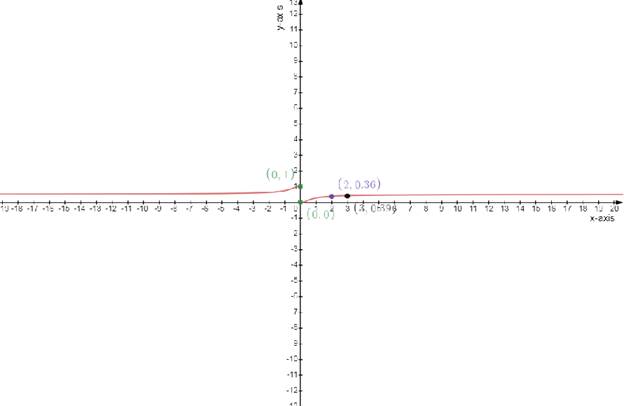
(a)
To graph:the given function
(a)
Explanation of Solution
Given:
The function is
Concept used:
The slope of the tangent to a curve
The tangent to be horizontal so the slope should be equal to 0
That is
Calculation:
The function is
Draw the table
Test one point in each of the region formed by the graph
If the point satisfies the function then shade the entire region to denote that every point in the region satisfies the function
Draw the graph

(b)
To find: The graph of
(b)
Answer to Problem 20RE
Explanation of Solution
Given:
The function
Concept used:
The definition of a vertical cusp is that the one sided limits of the derivative approach opposite
: positive infinity on one side and negative infinity on the other side . A vertical tangent has the one sided limits of the derivative equal to the same sign of infinity
The derivative at the relevant point is undefined in both the cusp and the vertical tangent
Calculation:
The function is
Differentiating equation (1) with respect to
(c)
To find:
The maximum and minimum values and the exact values.
(c)
Answer to Problem 20RE
Explanation of Solution
Given:
The function
Concept used:
The definition of a vertical cusp is that the one sided limits of the derivative approach opposite
: positive infinity on one side and negative infinity on the other side . A vertical tangent has the one sided limits of the derivative equal to the same sign of infinity
The derivative at the relevant point is undefined in both the cusp and the vertical tangent
Calculation:
The function is
Differentiating equation (1) with respect to
The vertical tangent means that the derivative at that point approaches infinity
Since the slope is infinitely large
(d)
To find:
The maximum and minimum values and the exact values.
(d)
Answer to Problem 20RE
Explanation of Solution
Given:
The function
Concept used:
The definition of a vertical cusp is that the one sided limits of the derivative approach opposite
: positive infinity on one side and negative infinity on the other side . A vertical tangent has the one sided limits of the derivative equal to the same sign of infinity
The derivative at the relevant point is undefined in both the cusp and the vertical tangent
Calculation:
The function is
Differentiating equation (1) with respect to
The vertical tangent means that the derivative at that point approaches infinity
Since the slope is infinitely large
(e)
To find:
The maximum and minimum values and the exact values.
(e)
Answer to Problem 20RE
Explanation of Solution
Given:
The function
Concept used:
The definition of a vertical cusp is that the one sided limits of the derivative approach opposite
: positive infinity on one side and negative infinity on the other side . A vertical tangent has the one sided limits of the derivative equal to the same sign of infinity
The derivative at the relevant point is undefined in both the cusp and the vertical tangent
Calculation:
The function is
Differentiating equation (1) with respect to
The vertical tangent means that the derivative at that point approaches infinity
Since the slope is infinitely large
Chapter 4 Solutions
Single Variable Calculus: Concepts and Contexts, Enhanced Edition
 Calculus: Early TranscendentalsCalculusISBN:9781285741550Author:James StewartPublisher:Cengage Learning
Calculus: Early TranscendentalsCalculusISBN:9781285741550Author:James StewartPublisher:Cengage Learning Thomas' Calculus (14th Edition)CalculusISBN:9780134438986Author:Joel R. Hass, Christopher E. Heil, Maurice D. WeirPublisher:PEARSON
Thomas' Calculus (14th Edition)CalculusISBN:9780134438986Author:Joel R. Hass, Christopher E. Heil, Maurice D. WeirPublisher:PEARSON Calculus: Early Transcendentals (3rd Edition)CalculusISBN:9780134763644Author:William L. Briggs, Lyle Cochran, Bernard Gillett, Eric SchulzPublisher:PEARSON
Calculus: Early Transcendentals (3rd Edition)CalculusISBN:9780134763644Author:William L. Briggs, Lyle Cochran, Bernard Gillett, Eric SchulzPublisher:PEARSON Calculus: Early TranscendentalsCalculusISBN:9781319050740Author:Jon Rogawski, Colin Adams, Robert FranzosaPublisher:W. H. Freeman
Calculus: Early TranscendentalsCalculusISBN:9781319050740Author:Jon Rogawski, Colin Adams, Robert FranzosaPublisher:W. H. Freeman
 Calculus: Early Transcendental FunctionsCalculusISBN:9781337552516Author:Ron Larson, Bruce H. EdwardsPublisher:Cengage Learning
Calculus: Early Transcendental FunctionsCalculusISBN:9781337552516Author:Ron Larson, Bruce H. EdwardsPublisher:Cengage Learning





